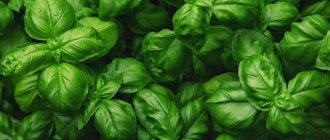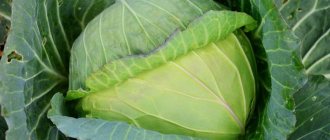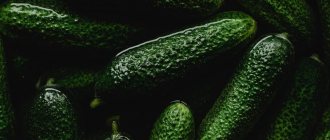Mint is a healthy spice that adds a refreshing, cool note to a variety of dishes and drinks. Unfortunately, like other greens, it is not stored fresh after cutting for long, but its shelf life can be significantly extended if you know certain tricks. Keeping the spice fresh for the winter is difficult; most often it is stored dried, but then dishes with it turn out less aromatic and rich. How long does mint last in the refrigerator and freezer? What ways can you keep it fresh for a long time? The various storage methods and nuances are discussed later in the article.
- 6.1. Video: How to preserve MINT for the winter? The best ways!
Main features of storage and collection
There are several known methods to keep mint fresh for a long time. They are simple, but some nuances are worth considering:
- The plant accumulates the maximum amount of useful components at the beginning of summer. This is the period when it blooms. The natural process indicates the need for harvesting for later storage.
- For long-term storage, choose young plants with densely planted leaves. They contain the maximum amount of essential oils.
- You need to cut mint and lemon balm in the morning, after the dew has disappeared.
These conditions are advisory in nature; you can collect herbs for preparations at other times, but following the listed rules will allow you to obtain the most useful raw materials.
Before storing, you need to prepare the raw materials:
- Sort the stems, remove dry leaves, remove other herbs and other debris.
- Rinse the plant under running water and shake off the water.
- Place on newspapers or paper towels and leave until moisture has completely evaporated from the surface of the leaves.
Attention! If only leaves are used to create the blank, they need to be separated from the stems. It is better to work with your hands; contact with a metal tool accelerates the deterioration of the product.
When to harvest mint?
The choice of procurement dates depends on the purposes for which the raw materials are collected. If for use in cosmetics, cooking, or for treatment, then it is harvested during flowering - during this period the plant is maximally saturated with useful substances. There are no exact dates - the flowering period depends on:
- type;
- varieties;
- climate of the area;
- growing conditions;
- care
If greens are needed for flavor, for use in home canning, jams, aromatic teas, then the stems are cut off at a young age before the buds appear. Regular cutting of young shoots stimulates the growth of new ones, so you can harvest several times a season.
To obtain high-quality and healthy raw materials, you need to follow certain rules:
- do not harvest mint growing near a road, industrial zone, or within the city - the leaves and stems accumulate harmful substances;
- for medicinal preparations, collect mature plants in the flowering stage;
- choose specimens that have sprouted side shoots, without signs of disease, bright, juicy;
- cut (do not tear off) 1/3 of the length, not the entire stem - if you cut the entire shoot, new ones may not grow back;
- The collection should be carried out in dry weather, when the dew has dried, preferably before the midday heat, in order to preserve essential oils;
- to preserve them during long-term transportation, wrap the stems in a damp cloth;
Attention! First spray dusty plants with a hose or watering can, allow them to dry and only then cut them off.
How to keep mint fresh
Mint leaves have delicate outer tissue, so they quickly wither after picking. The branches retain their turgor for no more than 2-3 hours after cutting, but knowing certain secrets, the duration of fresh storage without freezing can be significantly increased.
There are several simple methods:
- The picked mint is stored at room temperature in a container with clean water (like a bouquet). In this case, the stem is first cut obliquely with a sharp knife, and the leaves are cut off at the base to prevent rotting. The water should be changed every day. A simple method allows you to extend the freshness of the plant for 3-5 days (depending on the quality of the raw materials); if the mint has been without water for a long time, its freshness period will decrease to 2 days.
- The mint is washed under cold water and dried on a paper towel. The plant is placed in a sealed plastic container and placed in a cool place; contact with sunlight must be avoided. The maximum duration of freshness is 4 days.
You can preserve the juiciness of mint leaves for 10 days or more by storing it in the refrigerator. In this case, attention is paid to the original quality of the raw materials; damaged branches are not suitable for long-term storage. The spread of rot and other lesions can cause the entire stock to be lost. The branches are placed in a plastic container or wrapped in a paper towel and stored in the vegetable compartment.
If after collecting the mint it is not possible to immediately place it in a container with water, it is recommended to wrap the stems in a damp cloth and place them in a plastic bag. Then the plant will not begin to wither immediately.
Attention! When stored in the refrigerator, mint should be “isolated” from other foods because it has a rich aroma that can spread to other foods stored in the refrigerator.
If mint needs to be kept fresh for about 10-14 days, the best solution is to store it in the refrigerator. If the conditions are met, the spice will retain its smell and taste. Appearance may be slightly altered because leaves darken quickly after harvest.
Drying of medicinal raw materials
Drying mint is very easy. It is best to do this at room temperature, without using an oven or electric dryer. This will maximize the preservation of vitamins and nutrients in the greens.
There are two ways to dry mint at home:
- Tie the plants into small bunches. Hang the workpieces in a dry, ventilated place, protected from sunlight. This could be a shed, attic, shed or porch in the house. The apartment has a balcony with closed windows. Preparation time is 7-10 days, but everything is individual. Plants must dry completely. Check for doneness before storing bundles. Well-dried leaves and stems can be easily crushed with your fingers.
- To dry individual leaves for the winter, separate them from the stems and spread them on a cloth in a small layer. Check and turn the raw materials periodically. And in this case, choose a well-ventilated, semi-dark room. Leaves dried in the light lose their color and aroma.
How to dry mint collected from the garden or purchased depends on its subsequent use:
- The stems are the basis for the medicine.
- Leaves can be used in different ways.
After finishing the drying process, do not grind them into crumbs; do this just before use. Drink tea with them, prepare a mint decoction, or add to prepared dishes.
The medicinal properties of mint are used very widely: from brewing teas during colds to medicinal baths for skin rashes
We answer the question: how long can mint infusion be stored?
The mint infusion can be used for no more than a day and is the only one left in the refrigerator. With longer storage, its chemical composition changes, it becomes at least useless.
Alcohol tincture is suitable for treatment for about a year. After this, its composition will also begin to change and deteriorate due to the interaction of alcohol and substances contained in mint.
Drying mint greens is convenient for those who want to make preparations for a long time. The maximum shelf life of the medicinal plant is until the next harvest.
Freezer storage
For long-term storage, mint should be frozen. To do this, the spice must be properly prepared:
- the raw materials are washed under running water;
- lay out on newspapers or paper towels and wait until the moisture is completely removed;
- If you plan to freeze only the leaves, you need to remove them from the stem.
It must be remembered that mint, like any greens that have been frozen, should not be subjected to it again after thawing. Periodic temperature changes during storage will inevitably lead to loss of taste and aroma, then you won’t be able to please your loved ones with mint tea in the winter.
Freezing mint leaves
Leaves should be removed from the stem by hand, without using metal scissors or pruners. There should be no traces of moisture on their surface. The raw materials are placed in a thick plastic bag equipped with a zip fastener. If there is no special bag for freezing, the air from the package must be removed using a straw. Mint leaves frozen using this method in compliance with all conditions retain their taste and beneficial qualities for 1 year.
Freezing whole branches
Raw materials are used to create various dishes and cocktails, prepare medicinal decoctions and infusions used for cosmetic purposes. To ensure freezing, washed and dried raw materials are packaged in ordinary plastic bags, placing 3-5 branches in each. Freezing in large portions is pointless; the required amount of frozen mint will be difficult to separate. Packets of mint are rolled into a tight tube and placed against the back wall of the freezer, in the compartment with vegetables and fruits.
Freezing leaves in ice cubes
The advantage of this method is the portioned packaging of greens. Mint is frozen in ice cube trays or candy boxes. The cooking process is as follows:
- 2-3 washed mint leaves are placed in each compartment of the mold;
- add water, filling it completely;
- place in the freezer for 3-4 minutes.
It is not necessary to store the product directly in ice trays. You can remove the cubes after freezing and place them in a plastic container so as not to occupy the mold.
There are enough ways to ensure mint is frozen for the winter, so the housewife can choose the optimal method at her discretion. If fresh mint is used for cooking, consider freezing the leaves and whole branches. If the main purpose is making cocktails and using them in cosmetology, the method of freezing in cubes is convenient. You can make the preparation in several versions, in small portions.
Freezing for culinary purposes
Freezing allows you to preserve as much as possible the beneficial substances that mint is rich in. Many housewives prepare this product for the winter. It's convenient and doesn't take much time. At low temperatures, the workpieces are perfectly stored for 6-9 months without loss of quality and appearance.
If you choose this method, here are some options for freezing mint for the winter:
- Prepared twigs in the amount of 5-10 pcs. Place entirely in regular packaging bags. Place them in the freezer. A day later, when the stems and leaves are frozen, place them more tightly in one common package so that they do not take up space.
- Finely chop the greens with a knife and place the slices in containers with a lid. Then immediately send them to storage in the chamber. You can do the same with whole leaves, if you need this format of blanks.
- Freeze plant tops and leaves for drinks in ice cubes. Place the greens in molds and fill with cooled boiled water. After a day, remove the container from the chamber, pour the cubes into a bag and immediately put it back in the freezer.
The latter method is ideal for making mojitos, both alcoholic and non-alcoholic. Along with whole mint leaves, you can add a piece of orange or lemon zest, cut into long strips and twisted into a spiral, to the preparation.
Tip of the day
Do not remove the preparations from the freezer until ready to use. Do not refreeze the product. Ruin both your dish and your mood.
Waste-free freezing technology is shown in this video:
Frozen mint is ideal for cooking, but not suitable for use as medicine. If you need plants specifically for this purpose, then use the traditional method of obtaining raw materials - drying. How to properly dry mint and how to store it, read below.
Dried mint
Most often, mint is dried for long-term storage. The optimal collection time is July-August. At this time, the leaves retain essential oils in maximum concentration, so the pleasant menthol smell, if dried raw materials are properly stored, lasts for several years.
Recommendations for creating a blank come down to a simple algorithm:
- the branches are washed and slightly dried;
- collected in bundles of 10-15 pieces. and hung or laid out in a dry, dark place (contact with sunlight should be excluded);
- after complete drying, remove leaves and inflorescences from the branches;
- the raw materials are ground in a mortar or crushed by hand.
You need to store mint in linen bags or jars with a lid. The spice is added to ready-made dishes: soups, roasts, pilaf. In this form, it is stored for 1-2 years, but if the expiration date has expired, you should not throw it away. You can prepare a decoction based on it for taking baths.
Attention! Do not dry mint in the oven or microwave.
The best recipes for preparation
In order to brew vitamin tea during the winter cold or cure bronchitis, you need to try to preserve the beneficial characteristics of the plant. Taking care of this begins at the step of collecting raw materials. Only flowering plants are suitable for harvesting. You can tear off individual leaves or stems, but not completely, but only the upper third part.
Fundamentally! Raw materials need to be prepared for long-term storage.
Preparation consists of the following:
- sorting, in other words, removing dry, brown, damaged stems and leaves;
- rinsing under running water;
- drying. This is done like this: the wet raw materials are laid out on a dry towel for a maximum of an hour. It is better to stir up the grass from time to time.
Drying
The most common and most common harvesting method is drying. Dried weed can be stored for up to a couple of years. You can dry them either in bunches or individual leaves. Well-ventilated rooms, a shady space in the yard, or an open area with a canopy are suitable for drying. It is important that the raw materials are not exposed to the sun, but the temperature remains quite high.
Attention! Drying mint in the oven or on the windowsill is strictly prohibited!
The bundles are hung on ropes, and the leaves are laid out on paper or cotton fabric (a medical system of cells and intercellular substance, united by a common origin, structure and functions)
. Once drying is complete, transfer everything into canvas bags or plastic containers. Store in a dark place.
Freezing
With all this method, not only the spicy smell is preserved, but also the catchy color. All parts of the plant can be frozen. You can freeze it in different ways:
- the trunks are completely placed in the bag;
- leaves and tops of shoots are placed in small containers and jars;
- for confectionery products, a paste of mint ground in a blender, frozen in ice trays, is suitable;
- In the same forms, small leaves are frozen with a small amount of water. The resulting cubes are a good decoration for celebratory cocktails.
Mint syrup
Most of us probably associate the taste of mint syrup with childhood colds. You don't have to buy it at the pharmacy. It is easy to make. The calculation of goods is done based on a 1:1 ratio, in other words, 1 kg of sugar is taken per 1 kg of raw natural material. For such a quantity of goods, 1 glass of water will be useful.
- put water and sugar on low heat;
- add chopped mint to it;
- cook until sugar is completely dissolved;
- Remove from heat, cover and leave at room temperature until cool;
- strain through a sieve or cheesecloth and pour into glass bottles.
There are no special storage requirements. It is enough if the bottles are kept in a cold place.
Homemade syrup is suitable not only for honey purposes. It can be diluted with water, combined with honey, citrus juice, added to baked goods, and even used instead of sauce.
Mint jam
Yes, yes, specifically jam!
Bright green in color, sweet and sour, aromatic and spicy at once. A unique dessert and topping for pancakes or ice cream, a sauce for meat, a salad dressing made from fresh herbs, and even an ingredient for a mojito. For jam you will need:
- granulated sugar – 1 cup;
- mint – 150 g;
- water – 1 glass;
- lemon – 1 pc.
Making jam lasts for a day.
Day 1: chop mint, cut lemons, add water and put on low heat. Bring to a boil, continue to cook with constant stirring for 15 minutes. Remove the foam that appears and the floating lemon seeds with a slotted spoon. Turn off heat, cover and leave until cool. At night (that is, in the dark)
put in the refrigerator.
Day 2: strain the broth, put it on the stove, add sugar, bring to a boil. After 5 minutes the jam is ready. All that remains is to pour into sterilized jars.
Reference! Lemon is replaced with lime from time to time.
Is it possible to store lemon balm in the refrigerator and freeze it for the winter?
Melissa is an aromatic medicinal plant common in central Russia. When a few leaves are added to ordinary tea, it becomes therapeutic: it normalizes the functioning of the nervous system and stabilizes blood pressure. But this decoction can only be consumed in the summer; keeping the plant fresh for a long time is quite difficult.
Homemade lemon balm collected at a summer cottage retains its freshness for about 7-10 days. The concentration of beneficial properties is constantly decreasing. To preserve lemon balm for a week, it should be placed in a vessel with water immediately after collection. The container is sent to the refrigerator. It is not recommended to freeze plant stems. Under the influence of low temperatures, the bulk of the beneficial properties are destroyed, therefore the optimal solution to ensure long-term storage is drying.
Common mistakes
It is very important to check the integrity of the leaves before storing the greens in the refrigerator. Sluggish or warped ones already lose their own taste and can begin to deteriorate in containers with a good product. Also, sudden changes in temperature will harm mint. Air humidity does not have to exceed 50-60 percent. Otherwise, the leaves will quickly wither. It is recommended to wrap the plant in a bag before putting it in the refrigerator. This will protect the mint from the external environment and temperature changes.
The best method for long-term storage
The simplest, most convenient way to store mint for a long time is in dried form. But, if you plan to use mint to create cocktails, drinks or any savory dishes, it is better to freeze it fresh. The best method is freezing in ice cubes. A lot of useful properties are partially lost in any long-term storage option.
The maximum duration for storing mint in the refrigerator is no more than 2 weeks, but it must be taken into account that the plant will gradually lose some of its beneficial properties. Freezing the plant allows you to preserve its benefits and freshness throughout the year. There are several ways to provide it: mint is frozen with leaves and stems, as well as in ice cubes. With so many options, choosing the one that suits you is very easy. It is much more difficult to ensure long-term storage of another aromatic herb - lemon balm. It retains its freshness in the refrigerator for no more than 10 days, and cannot be frozen. The optimal solution is to dry the raw materials for the winter.
Video: How to preserve MINT for the winter? The best ways!
How to preserve MINT for the winter? The best ways!
Watch this video on YouTube
Video: How to prepare mint for the winter? Drying or freezing?
How to prepare mint for the winter? Drying or freezing?
Watch this video on YouTube
Do you want to understand better than others?
- Storing chicken in the freezer - The presence of chicken in the diet of most people on the planet is due to its low calorie content and low price compared to other meat. It can be purchased whole or separately...
- Methods for storing lard in various forms in the refrigerator - Lard is animal fat in a solid state. The product is eaten in different ways of preparation: salted, smoked, boiled or fried. Depending on the…
- How to freeze boletus in fresh and cooked form - Frozen mushrooms are a popular product that is grown in specialized enterprises and sold in supermarkets. Wild mushrooms are much tastier and more aromatic...
- How much and how can you store soup in the refrigerator - Soup is a balanced meal that allows you to quickly fill up. Thanks to the many recipes, you can prepare different soups every day, but often you don’t have enough time...
- How to properly store and defrost minced meat - The basic ingredient in a large number of different dishes is minced meat. Housewives often buy ready-made semi-finished products in the store or store them for future use. Therefore special...
Additional tips and advice
For storage, use airtight containers; this is very important for preserving the taste properties of the plant. It is also important to sort out the product, because the properties of the weed depend on it. For long-term storage, the plant is dried. For feeding at home, it is enough to have one branch. After that, the seedling takes root, it is placed in the soil and is now cared for. The space is chosen with partial shade so that the mint receives enough light, and at the same time the rays do not damage the foliage.
Climatic conditions affect taste and smell. During the winter, if stored incorrectly, all this is lost. There is no need to prepare a lot, because the plant can be used economically. There may also be medicinal uses. I use molds to freeze in ice. This will help you use the space correctly. With proper processing and compliance with processing rules, a high-quality product is obtained that will retain its characteristics for a long time.
Useful tips for preparation
The purposes of the workpiece may be different.
Some people are first interested in its pharmaceutical characteristics, while others want to use mint in culinary experiments. The choice of harvesting method almost entirely depends on the goals pursued by the housewife. Do you want to extend the feeling of summer? It could be. The shoots stay fresh for about a month if stored in the refrigerator. The stems are tied into a bundle, placed in a container with a small amount of water, and covered with cling film. Individual leaves are wrapped in paper and placed in a plastic bag and sent to the bottom shelf of the refrigerator
When collecting mint, you need to follow several rules:
- the best months for collecting are July or August, and the time of day is morning or evening;
- the day should be fine and the plants dry;
- Avoid exposure to direct sunlight on newly harvested green mass;
- do not forget about nature, give it the right to restore and renew resources. How to create it? Just pluck off the tops, and don’t uproot entire bushes!
The most important thing! If you need a medicinal plant and not a poisonous one, collect it away from public roads and hazardous industries.
Naturally, the preparation of goods for the winter is gradually becoming a thing of the past, but this does not have to do with mint.
Requirements for leaves
- Only externally healthy plants can be stored. If mint leaves are damaged, white or faded, it is better to get rid of them immediately. They will not bring any benefit and can ruin the workpiece.
- The color of the leaves is uniform and rich, and when rubbed, the smell intensifies several times.
- Mint harvested during the harvest season is best suited for long-term storage. The period occurs at the end of July and beginning of August, when the plant contains a large amount of essential oil and emits a strong aroma.
How to use
This plant is valued not only for its pleasant, rich aroma, but also for its healing properties, which were often used by traditional healers. This is due to the high content of essential oils and tannins. For example, mint tea is good against nausea, heartburn, and flatulence. You need to add one tablespoon of the dried plant and pour a glass of hot water. After 10 minutes you can drink homemade, tasty medicine. It will also help get rid of the symptoms of angina pectoris.
Mint will also be useful for a child when he has skin rashes. It is necessary to carry out bath procedures with the addition of mint infusion. Men should not get carried away with tea with this plant, because it can affect “male strength.” Mint should not be used by people with low blood pressure due to its vasodilating properties. Otherwise, people can freely enjoy this beautiful plant.
Useful articles from the “Spicy” section:
Useful articles for gardeners:
- Sea buckthorn jam for the winter: recipes
- Planting Brussels sprouts in 2022: timing, cultivation and care
- Florist's lunar calendar for 2022
- Lunar calendar for indoor plants for March 2022
- Garden varnish: how to prepare it at home and how to use it
- How to get rid of aphids on cabbage: what to treat, effective methods
- When to dig up gladioli after flowering in 2022: favorable days
- When to dig up hazel grouse after flowering and how to store it properly
- Lunar calendar for gardeners and gardeners for July 2022: favorable days
- When to dig up daffodils after flowering in 2022: timing, how to store
Basic conditions
There are many ways to store mint, but a number of conditions must be met. It is worth ensuring the following:
- Dust and dirt on the leaves are unacceptable. Before storing, rinse and clean the plant under cold running water.
- No contact with sunlight. Direct exposure to sunlight negatively affects raw materials, as beneficial properties and freshness are lost.
- Sufficient humidity in the room or container where the mint is stored. Fresh mint requires as much water as possible, but for dry mint, excess air moisture provokes the process of rotting and spoilage of the product.
- Storage temperature should be below room temperature, which increases the “life span” of fresh mint.
- Keep away from seasonings, spices and foods that absorb odors. The strong aroma of mint can spoil other foods and vice versa.
Conditions also depend on the chosen storage method. For dried and frozen mint, they are radically different. In the first case, you need room temperature, in the second, cool conditions. The storage tanks used also differ.
Errors and their prevention
Mint may deteriorate due to improper storage conditions. For example, losing beneficial properties and smell due to prolonged exposure to direct sunlight.
High humidity provokes the process of rotting, as does poor insulation from air. To avoid mistakes, it is enough to follow the recommendations described in each storage method. Then the product will remain fresh for as long as possible, maintaining its beneficial properties.











